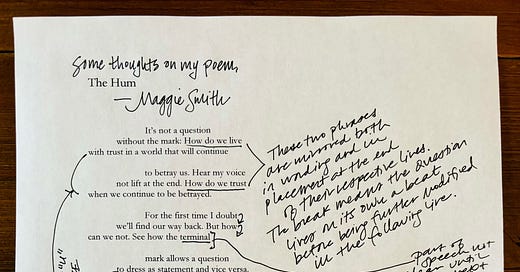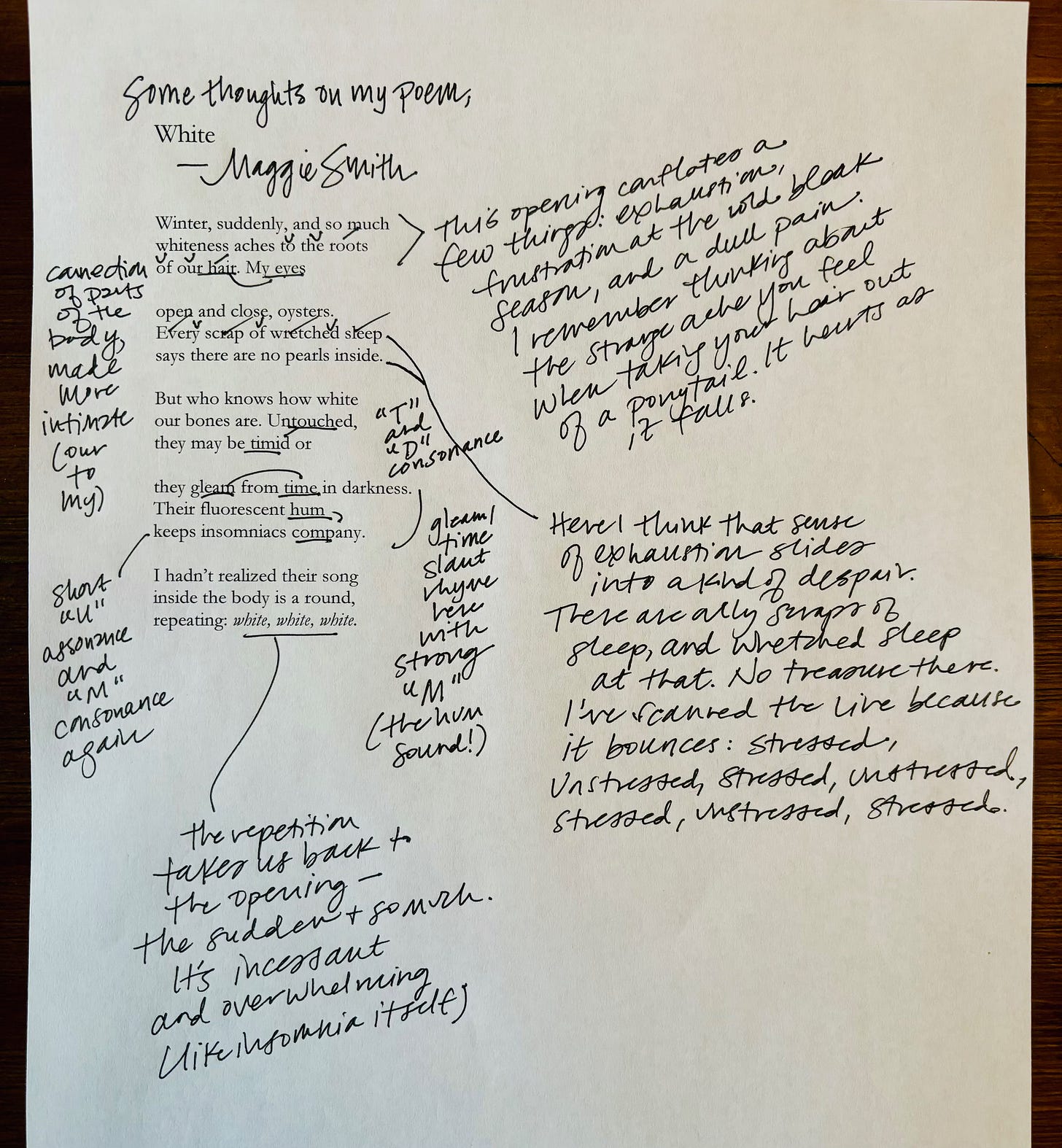Hi, Friend.
Between winter break with my kids and what, after more than a month, I started referring to as The Endless [insert expletive] Cold, it’s been a slog here. I hope the end of last year and the beginning of this one have been a little easier on you and yours.
Recently I was able to pack up my neti pot and NyQuil and head to a cabin in the woods for a weekend, where I did a deep dive on my next book. (More on that in the coming months!) It felt so good to do nothing but write, write, write—and it reminded me: No matter what else is going on in life, the writing is always there.
What a gift to have creativity as a faithful companion. And I believe that’s possible for all of us.
This week I’ve annotated a pair of poems that are in conversation with each other across several years and in different books: “The Hum” from Goldenrod and “White” from The Well Speaks of Its Own Poison. Keep an eye out for a craft tip and writing prompt related to these two poems over the next week, too. I hope you’ll find both generative and useful.
First up is “The Hum,” first published in New England Review, later included in my fourth book of poems, Goldenrod. The poem began as an exploration of what it means to express an unknown without expecting an answer or solution. When we see a question mark, we’re cued to raise our pitch at the end of the sentence. I remember this from teaching my own children how to read—encouraging them to scan to the end of the sentence to see if the terminal punctuation is a period, exclamation point, or question mark, because that changes the way you read the sentence aloud. It changes the color and temperature of the sentence.
Here in the annotation I’ve made notes about some of the craft decisions I made related to line breaks, sound, and the ways different parts of the poem are in conversation with each other.
Enjambment is doing a lot of work in this poem, with most of the line breaks being suspenseful, in that the reader doesn’t have a firm grasp of where the sentence is going. “For the first time I doubt” what? “How do we trust” what? The “fidelity” of what?
I see this as form enacting content: the poem is grappling with the unknown and a sense of being adrift. In fact, the speaker has such low expectation that there are answers to her questions, that she doesn’t pose them as proper questions. Even the soul doesn’t change its pitch with its pleas.
I gave a reading from Goldenrod last year, and when I read “The Hum,” it struck me that “Years ago I thought it was coming from my bones” referenced the poem “White” from my second book of poems, The Well Speaks of Its Own Poison, which was published six years before Goldenrod.
“White” dates back to 2003 and 2004, right after I received my MFA, though it didn't appear in book form until 2015. It was inspired by two things: my insomnia (still an issue all these years later) and the bleakness of an Ohio winter, which comes on suddenly and lasts several months. Neither is good for one’s mental health, that’s for sure. An Ohio winter tends to be cold, gray, and very overcast; often the ground and the sky are the same washed-out white. It’s everywhere.
I stand by the choice of tercets in the poem because of what happens in the last line. If the song is a round repeating, with a repetition in three (“white, white, white”), then three-line stanzas enact that round. (It’s funny—that “round” does not have a role in “The Hum,” and I was not consciously thinking back to “White” when I wrote that poem, but it’s also in tercets, just a slightly different shape. I like these serendipitous connections.)
There is less suspense and misdirection with the line breaks in this poem, but I do see enjambment being used to create a sense of unease (as the speaker herself feels uneasy). For example, “roots” in line two suggests trees, given that we are talking about winter, but that assumption is upended in the following line with “of our hair.”
Sound is particularly important in this poem, with the M consonance in gleam/time (also internal slant rhyme) and in hum/company (partial rhyme with the short U and M in hum/com here) enact the vibration of a hum. And as you can see in the annotation, I scanned a couple of lines where the rhythm stood out to me, including what I hear as two anapests (unstressed unstressed STRESSED) back to back, across lines two and three: to the ROOTS/ of our HAIR.
It really is wild to see how these poems call to each other across books and years—one poem written in 2003 or 2004, the other written in 2018, when I was struggling to face that my marriage was over. (“For the first time I doubt/ we’ll find our way back. But how/ can we not.”) Frankly it’s also wild to think about how many years I’ve struggled with sleep! But again, whatever life brings, the ability to create is there—to give experience a form. I don’t take that for granted.
“I like the feeling of being able to confront an experience and resolve it as art.”
—Eudora Welty
Thank you for being part of For Dear Life. I can’t believe it’s been almost a year since I launched this newsletter, and I’m glad you’re here.
Speaking of “here,” I have a few February events coming up. I’ll be at the AWP conference in Kansas City for a few days of panels and readings February 7-10, and at my local public library for my picture book launch on February 25. I hope you’ll come say hello if I’m in your neck of the woods.
Happy writing—
Maggie






Maggie, thank you for your work and these annotations. I’m an ‘04 OWU grad (Econ and Humanities-Classics) who has been reading about you for years via the OWU Alumni magazine, but I confess that it’s only recently I started reading your work.
Through your work I have come to appreciate my partner and her observations more, realizing that she too is an every day poet. The daughter of a mechanic from Defiance, Ohio, she has the most interesting and mundane observations that surprise and crack me up. For example, comparing certain sounds around the house or in nature to a loose timing belt or a faulty flywheel, or the motor on a fishing boat. They are markedly different from your poignant imagery, but I adore it.
Today I shared these two poems with her, a first. After I read “I can hear a small hum inside me, an appliance left running.” She interrupted to say “THAT’S TINNITUS!”
“No Penny, it’s not a literal humming!”
I read more until the part where you say the hum is the SOUL, but she still disagrees.
I think it’s because she actually has tinnitus right now from years of work in landscaping, drumming as a teenager, and DJing in loud clubs. It is one hum she can’t quite put to sleep.
I hope you find this as amusing as I do 😆 And thankfully she has an appointment with an ENT coming up 🤓
Maggie thank you for sharing these serendipitous connections. It gave words to something thats been floating in my periphery. I really love your behind the scenes discussion they are so rich. 🙏